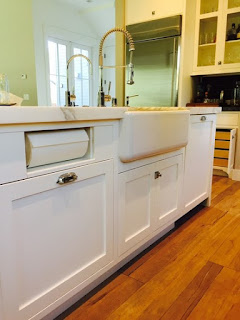8 Smart Lighting Strategies for Your Kitchen
by Eric Corey Freed
While many people planning a kitchen remodel
obsess over choosing the right material for countertops or finding the perfect wood for cabinets, lighting
is often overlooked and treated as an afterthought. But good lighting can
highlight the design of your kitchen, as well as make it more comfortable and
easier to use. Plus, if you leave kitchen lighting to the last minute, chances
are it'll cost you a pretty penny, especially if electrical wiring needs to be
reconfigured. Here are a few things you should consider before starting.
Out of the Spotlight

The most common kitchen lighting mistake is relying on a single bright source of light from above. This creates high contrast and glare, as well as uneven light around the kitchen. It also causes your head and body to cast a shadow over the area where you're working, making routine prep tasks harder to see. Dissolve those harsh shadows by setting your lights to overlap one another. If you've got recessed cans, position them within 2 or 3 feet of one another so their beams overlap. If you like the look of a central fixture, choose one that shines upward to bounce light off the ceiling for a more diffuse glow. Having multiple light sources and directions will eliminate this spotlight effect.
Let the Sun Shine
The best light for a kitchen is, of course,
natural light. Not only does it improve visibility, reduce electricity use and
provide a full spectrum of light, it turns out that we're happier in natural
daylight. Whenever possible, find opportunities to bring in natural light into
your kitchen. This can prove challenging if you're remodeling an existing
kitchen and want to keep costs low, but daylight fixtures, such as Solatube
or Sun Tunnel, can deliver natural light easily and
inexpensively. These simple skylights can penetrate an existing ceiling to wash
a once-dark kitchen with natural light.
Ambient lighting bathes the kitchen with enough light to see, but the detailed and focused work of chopping, mixing and reading recipes requires more concentrated light. Position lights that point downward directly above counter areas to illuminate these workspaces. Referred to as task lighting, these fixtures should be on a separate, dimmable switch for added control and positioned so they won't cast a shadow when you're working at the counter. If you're existing ceiling can't accommodate recessed lighting (or it's not the right fit for your house), you can get the same effect from under-cabinet lights, surface-mounted tracks or hanging pendant fixtures.
Accentuate the Positive
Once your kitchen's functional lighting
needs are satisfied, think about how you can use lighting to provide a design
accent. Easy-to-install items like counter edge lighting, toe kick lighting or
above-cabinet lighting can add a special touch. You can even wire toe kick
lighting to a motion sensor to create a unique kitchen nightlight.
Mind the Reflections
When planning your lighting layout, be
mindful of the way light reflects off the finishes in your kitchen. A dark backsplash will mirror under-cabinet lights; glass cabinet
doors will reflect the ceiling lights. While this may brighten up your kitchen,
it could also bring some unwanted glare. That black granite countertop might
look great in the showroom, but once it's installed in your kitchen, it may end
up like a giant mirror that blinds you from the ceiling lights.
Focal Points
If you've got a special bar or seating nook, pretty or colorful fixtures will help drawn attention to
it. (If you choose a pendant, an odd number of lights look better—think one or
three—than even.) Ceiling fixtures aren't the only ones that can draw the
eye—wall sconces can frame a view, splash light on nice wall finish or match
the hardware on the cabinets. Remember, these fixtures won't be your main
source of light; they're really meant to complement the design.
Under Control
Once you've got your lighting strategy
mapped out, you want to be able to control the lights. If you're doing
additional wiring anyway, separate switches are relatively cheap to install.
Dimmer switches provide the opportunity to create ambience and mood. If you
have an older house, push-button dimmers, such as the mother of pearl ones from Rejuvenation, will add a bit of
history at the same time.
Energy Matters
 Many states, like California and New York,
require energy efficient bulbs for primary lighting (i.e., the first switch you
flip). People often complain about the look of compact fluorescent (CFL) bulbs,
but there are other energy-saving alternatives. LED (light emitting diode)
technology continues to leap forward—the price of LED bulbs drops daily—and
provides the best options for color, long life, dimmability and energy savings.
All of the strategies outlined here can incorporate LED technology.
Many states, like California and New York,
require energy efficient bulbs for primary lighting (i.e., the first switch you
flip). People often complain about the look of compact fluorescent (CFL) bulbs,
but there are other energy-saving alternatives. LED (light emitting diode)
technology continues to leap forward—the price of LED bulbs drops daily—and
provides the best options for color, long life, dimmability and energy savings.
All of the strategies outlined here can incorporate LED technology.
Lighting is vital to having a beautiful and functioning kitchen. Confused? Let Cabinet-S-Top assist you in choosing the best lighting fixtures for your kitchen.








I am very happy to read such a wonderful blog which gives the helpful information. thanks for sharing.
ReplyDeleteKitchen Ideas
Design A Kitchen Remodel
Country Kitchen Cabinets
Bathroom Remodel
Flooring Installation